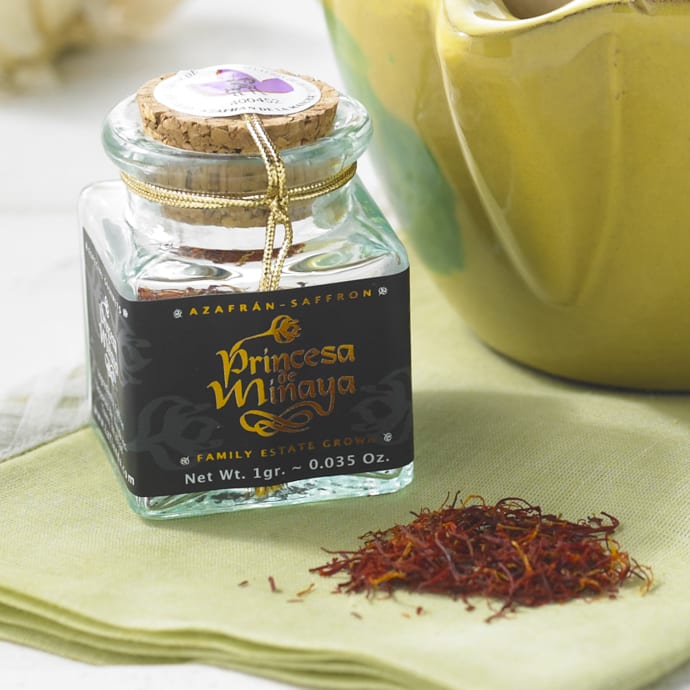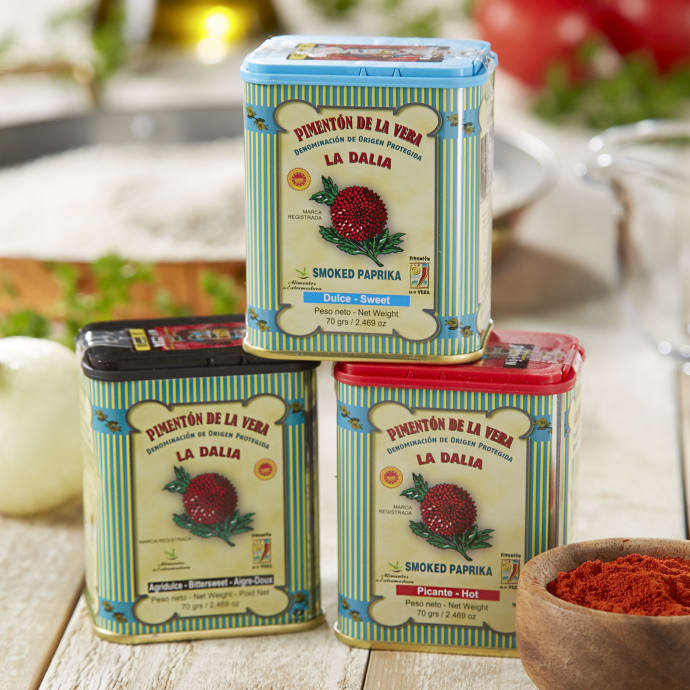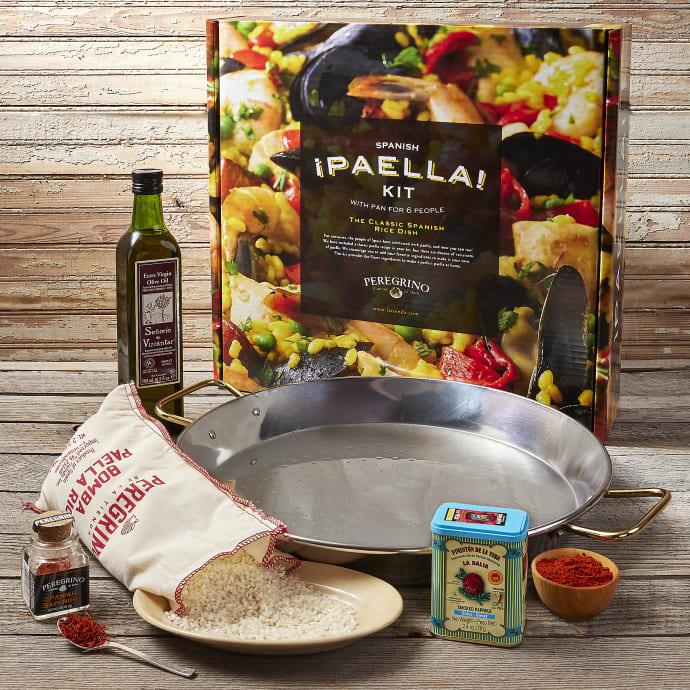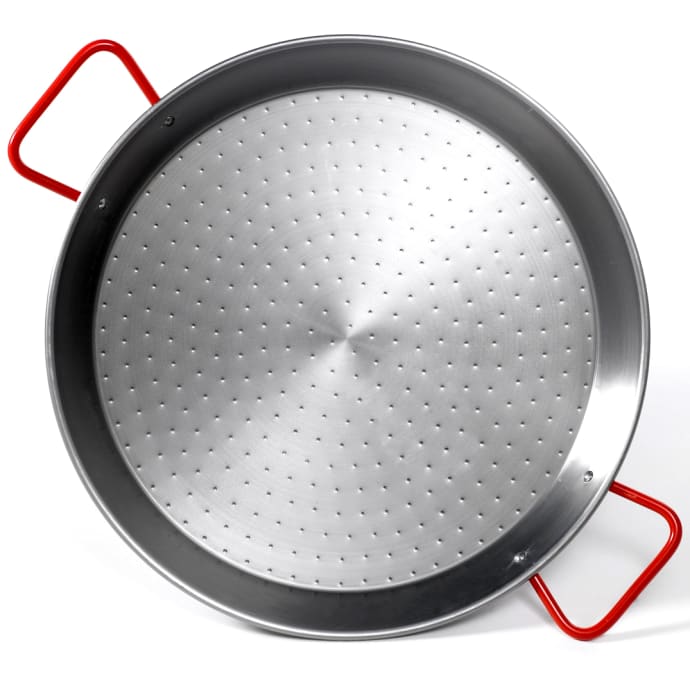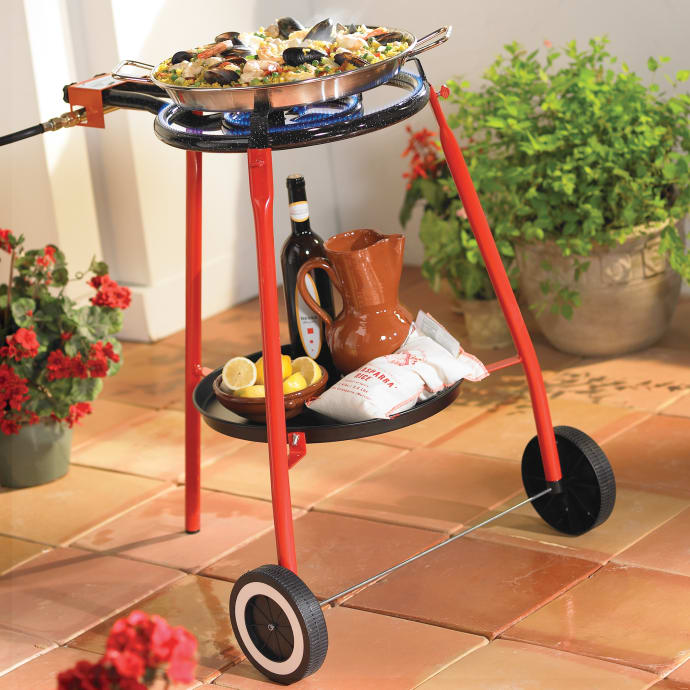
Paella for Parties
The Journal Gazette
-
January 1, 2007
Paella permeates party with international flavor
Erica Marcus
In the pantheon of great international party dishes, you'd be hard-pressed to find one more misunderstood than paella.
Here's what paella is not: It is not a yellow rice casserole. It is not a repository for all manner of meats and vegetables. It is not the Spanish national dish.
What paella is is a method of cooking rice, native to Valencia on Spain's eastern coast, that involves sautéing ingredients in olive oil in a wide, shallow pan, adding rice and liquid and then cooking, uncovered and with a minimum of stirring, until the rice is just tender.
Penelope Casas, an authority on Spanish food (and the author of many cookbooks), explained that the name refers to the pan in which paella is cooked. "The paella -- the pan -- is wide and shallow," she said. "It is made from carbon steel, it heats up quickly, and over time it discolors and gets ugly-looking." (In other words, don't spend your money on a $200 paella pan; you can get the real thing for about $40.)
In Valencia, Casas said, there are restaurants devoted to making paella. Some make the dish in their kitchens, others use a specially made propane burner-on-a-tripod, still others cook paella in the most traditional way: over an open wood fire.
In her definitive book "Paella! Spectacular Rice Dishes From Spain" (Henry Holt), Casas adapts traditional recipes for the American home cook. And she is bullish that a true paella requires nothing that can't be easily obtained in most supermarkets. "The only indispensable ingredients are rice, water and olive oil," she writes. "Everything else is the subject of endless debates and discussions by Spaniards."
When Casas published "Paella" in 1999, short-grain Spanish rice was hard to find on U.S. shores. But the recent push by Spain to introduce its foods to Americans has brought many more imported products into specialty stores. Optimally, Casas would have us use the highest-quality Spanish short-grain rice, called Bomba, for paella. But she has also made entirely creditable -- if unusually creamy -- paellas with Italian Arborio rice; she particularly likes Beretta's Superfino brand.
The yellow color of some paellas comes from saffron, but Casas said that it is really a supporting player most of the time. Still, it's worth seeking out high-quality, authentic Spanish "thread" saffron that hasn't been pulverized into an orange powder. Ditto Spanish paprika Ð pimenton Ð which has a haunting, smoky quality all its own. All manner of Spanish foodstuffs and cooking utensils are available from the excellent Spanish cooking Web site, www.tienda.com.
In Valencia, paellas tend to be either meat or seafood and not both. This delicious paella owes its intense clam flavor to use of two kinds of clams. The larger ones are steamed open, then the meat chopped and the broth used as the paella's liquid. The smaller ones are placed in their shells directly on the paella to steam open while the dish cooks. To cleanse clams, place them in a bowl and cover them with heavily salted water (think seawater) and a tablespoon of cornmeal or flour. Leave for a few hours or overnight in the refrigerator. Before using, scrub them well. To make this paella outdoors on a charcoal grill, follow the method in the recipe for traditional Valencian paella.
Garlicky Clam Paella
1 dozen large littleneck or top neck clams, cleansed
1/2 cup minced parsley
6 medium cloves garlic, minced
1/8 teaspoon crumbled thread saffron
Kosher salt
1/4 cup dry white wine
2 teaspoons lemon juice
4 tablespoons olive oil
1/2 cup minced onion
1/4 cup well-washed, minced leeks (white parts only)
1 small green bell pepper, finely chopped
1 bay leaf
1 (1-inch) piece dried red chile pepper, or 1/4 teaspoon crushed red pepper
1/3 teaspoon sweet paprika, preferable Spanish smoked (pimenton)
1 1/2 cups imported Spanish short-grain or Italian Arborio rice
32 Manila clams, or 24 New Zealand cockles, cleansed
1. Place large clams in a skillet with 3 cups water. Bring to a boil, cover and cook, removing clams as they open. Swish clams in the broth to remove any sand, then shake dry and chop coarsely. Set aside. Pour liquid through a fine-mesh sieve lined with cheesecloth or 1 layer of a 2-ply paper towel. Measure out 2 3/4 cups and set aside. Reserve additional broth for another use.
2. Set aside 2 tablespoons parsley. In a mortar or mini processor, mash to a paste the remaining parsley, garlic, saffron and 1/8 teaspoon salt. Set aside.
3. When ready to cook, preheat oven to 400 for gas, 450 for electric. Warm broth over a low flame. Have premeasured and ready to go: Onion, leeks, pepper, bay leaf, chile pepper, chopped clams, paprika, rice and Manila clams. Combine mortar mixture (parsley, garlic, saffron, salt) with wine and lemon juice.
4. Heat the oil in a paella pan measuring about 13 inches (or in a shallow casserole of a similar size) and slowly saut? the onion, leeks, pepper, bay leaf and chile pepper until the vegetables are softened. Add the chopped clams and saut? 5 minutes more. Remove the bay leaf and chile pepper, and stir in the paprika. Add the rice and coat well with the pan mixture. Pour in the broth, bring to a boil, taste for salt, add the mortar-wine-lemon juice mixture and Manila clams and boil, stirring occasionally, for about 5 minutes, until the rice is no longer soupy but sufficient liquid remains to continue cooking the rice.
5. Transfer to the oven and cook, uncovered, 10 to 12 minutes in a gas oven, or 15 to 20 minutes in an electric oven, until the rice is almost al dente. Remove to a warm spot, cover with foil and let sit 5 to 10 minutes, until the rice is cooked to taste.
6. To achieve a crusty bottom, return the paella to the stove over high heat and cook, without stirring, until a crust of rice forms at the bottom of the pan. Be careful not to let it burn. Sprinkle with remaining parsley and serve.
Makes 4 servings.
Make preparation easier
Paella makes a show-stopping centerpiece for a special-occasion meal. Because it is fairly labor-intensive and must be completed at the last minute, the best strategy for serving it to company is to select accompaniments that require a minimum of effort, like opening a can.
As it happens, Spain is famous for its canned products. Consider serving stuffed olives (pimentos, almonds, cheese, tuna or anchovy paste are all common fillers), ventresca (tuna belly) preserved in olive oil, or piquillos, the distinctive pointy red peppers from the region of Navarra.
Spain produces a number of great cheeses, among them Manchego, a forceful sheep's milk cheese from La Mancha (like Don Quixote); Idiazabal, a smoked goat cheese from the Basque region; Tetilla, a mild cow's milk cheese from Galicia; and Cabrales, from Asturias, one of the world's great blues.
What goes better with cheese than ham? A few years ago, the U.S. Department of Agriculture lifted its ban on serrano, Spain's version of Italian prosciutto. The best serrano, made from the hind legs of acorn-fed Iberico pigs, won't be available here until 2007, but in the meantime, you can buy chorizo sausage and lomo (cured pork loin) made from Iberico pigs.
Most specialty markets stock a good selection of Spanish canned goods, cheeses and ham or go online to tienda.com.
To drink, try a sampler of Spanish wines. We started with a sparkling Cava, Codorniu Brut, Cuvee aventos (about $10) and a crisp white Albarino, Rias Baixas, Martin Codax (about $14). With the clam paella, a ros?, Gran Feudo, Julian Chivite (about $10) and, with the Valencian paella, a classic Rioja, Marques de Riscal, Reserva (about $15). You'll want a simple dessert, perhaps a flan, or, even simpler, vanilla or dulce de leche ice cream topped with toasted almonds.
Erica Marcus
In the pantheon of great international party dishes, you'd be hard-pressed to find one more misunderstood than paella.
Here's what paella is not: It is not a yellow rice casserole. It is not a repository for all manner of meats and vegetables. It is not the Spanish national dish.
What paella is is a method of cooking rice, native to Valencia on Spain's eastern coast, that involves sautéing ingredients in olive oil in a wide, shallow pan, adding rice and liquid and then cooking, uncovered and with a minimum of stirring, until the rice is just tender.
Penelope Casas, an authority on Spanish food (and the author of many cookbooks), explained that the name refers to the pan in which paella is cooked. "The paella -- the pan -- is wide and shallow," she said. "It is made from carbon steel, it heats up quickly, and over time it discolors and gets ugly-looking." (In other words, don't spend your money on a $200 paella pan; you can get the real thing for about $40.)
In Valencia, Casas said, there are restaurants devoted to making paella. Some make the dish in their kitchens, others use a specially made propane burner-on-a-tripod, still others cook paella in the most traditional way: over an open wood fire.
In her definitive book "Paella! Spectacular Rice Dishes From Spain" (Henry Holt), Casas adapts traditional recipes for the American home cook. And she is bullish that a true paella requires nothing that can't be easily obtained in most supermarkets. "The only indispensable ingredients are rice, water and olive oil," she writes. "Everything else is the subject of endless debates and discussions by Spaniards."
When Casas published "Paella" in 1999, short-grain Spanish rice was hard to find on U.S. shores. But the recent push by Spain to introduce its foods to Americans has brought many more imported products into specialty stores. Optimally, Casas would have us use the highest-quality Spanish short-grain rice, called Bomba, for paella. But she has also made entirely creditable -- if unusually creamy -- paellas with Italian Arborio rice; she particularly likes Beretta's Superfino brand.
The yellow color of some paellas comes from saffron, but Casas said that it is really a supporting player most of the time. Still, it's worth seeking out high-quality, authentic Spanish "thread" saffron that hasn't been pulverized into an orange powder. Ditto Spanish paprika Ð pimenton Ð which has a haunting, smoky quality all its own. All manner of Spanish foodstuffs and cooking utensils are available from the excellent Spanish cooking Web site, www.tienda.com.
In Valencia, paellas tend to be either meat or seafood and not both. This delicious paella owes its intense clam flavor to use of two kinds of clams. The larger ones are steamed open, then the meat chopped and the broth used as the paella's liquid. The smaller ones are placed in their shells directly on the paella to steam open while the dish cooks. To cleanse clams, place them in a bowl and cover them with heavily salted water (think seawater) and a tablespoon of cornmeal or flour. Leave for a few hours or overnight in the refrigerator. Before using, scrub them well. To make this paella outdoors on a charcoal grill, follow the method in the recipe for traditional Valencian paella.
Garlicky Clam Paella
1 dozen large littleneck or top neck clams, cleansed
1/2 cup minced parsley
6 medium cloves garlic, minced
1/8 teaspoon crumbled thread saffron
Kosher salt
1/4 cup dry white wine
2 teaspoons lemon juice
4 tablespoons olive oil
1/2 cup minced onion
1/4 cup well-washed, minced leeks (white parts only)
1 small green bell pepper, finely chopped
1 bay leaf
1 (1-inch) piece dried red chile pepper, or 1/4 teaspoon crushed red pepper
1/3 teaspoon sweet paprika, preferable Spanish smoked (pimenton)
1 1/2 cups imported Spanish short-grain or Italian Arborio rice
32 Manila clams, or 24 New Zealand cockles, cleansed
1. Place large clams in a skillet with 3 cups water. Bring to a boil, cover and cook, removing clams as they open. Swish clams in the broth to remove any sand, then shake dry and chop coarsely. Set aside. Pour liquid through a fine-mesh sieve lined with cheesecloth or 1 layer of a 2-ply paper towel. Measure out 2 3/4 cups and set aside. Reserve additional broth for another use.
2. Set aside 2 tablespoons parsley. In a mortar or mini processor, mash to a paste the remaining parsley, garlic, saffron and 1/8 teaspoon salt. Set aside.
3. When ready to cook, preheat oven to 400 for gas, 450 for electric. Warm broth over a low flame. Have premeasured and ready to go: Onion, leeks, pepper, bay leaf, chile pepper, chopped clams, paprika, rice and Manila clams. Combine mortar mixture (parsley, garlic, saffron, salt) with wine and lemon juice.
4. Heat the oil in a paella pan measuring about 13 inches (or in a shallow casserole of a similar size) and slowly saut? the onion, leeks, pepper, bay leaf and chile pepper until the vegetables are softened. Add the chopped clams and saut? 5 minutes more. Remove the bay leaf and chile pepper, and stir in the paprika. Add the rice and coat well with the pan mixture. Pour in the broth, bring to a boil, taste for salt, add the mortar-wine-lemon juice mixture and Manila clams and boil, stirring occasionally, for about 5 minutes, until the rice is no longer soupy but sufficient liquid remains to continue cooking the rice.
5. Transfer to the oven and cook, uncovered, 10 to 12 minutes in a gas oven, or 15 to 20 minutes in an electric oven, until the rice is almost al dente. Remove to a warm spot, cover with foil and let sit 5 to 10 minutes, until the rice is cooked to taste.
6. To achieve a crusty bottom, return the paella to the stove over high heat and cook, without stirring, until a crust of rice forms at the bottom of the pan. Be careful not to let it burn. Sprinkle with remaining parsley and serve.
Makes 4 servings.
Make preparation easier
Paella makes a show-stopping centerpiece for a special-occasion meal. Because it is fairly labor-intensive and must be completed at the last minute, the best strategy for serving it to company is to select accompaniments that require a minimum of effort, like opening a can.
As it happens, Spain is famous for its canned products. Consider serving stuffed olives (pimentos, almonds, cheese, tuna or anchovy paste are all common fillers), ventresca (tuna belly) preserved in olive oil, or piquillos, the distinctive pointy red peppers from the region of Navarra.
Spain produces a number of great cheeses, among them Manchego, a forceful sheep's milk cheese from La Mancha (like Don Quixote); Idiazabal, a smoked goat cheese from the Basque region; Tetilla, a mild cow's milk cheese from Galicia; and Cabrales, from Asturias, one of the world's great blues.
What goes better with cheese than ham? A few years ago, the U.S. Department of Agriculture lifted its ban on serrano, Spain's version of Italian prosciutto. The best serrano, made from the hind legs of acorn-fed Iberico pigs, won't be available here until 2007, but in the meantime, you can buy chorizo sausage and lomo (cured pork loin) made from Iberico pigs.
Most specialty markets stock a good selection of Spanish canned goods, cheeses and ham or go online to tienda.com.
To drink, try a sampler of Spanish wines. We started with a sparkling Cava, Codorniu Brut, Cuvee aventos (about $10) and a crisp white Albarino, Rias Baixas, Martin Codax (about $14). With the clam paella, a ros?, Gran Feudo, Julian Chivite (about $10) and, with the Valencian paella, a classic Rioja, Marques de Riscal, Reserva (about $15). You'll want a simple dessert, perhaps a flan, or, even simpler, vanilla or dulce de leche ice cream topped with toasted almonds.
Other Press
The Winter Travel Shortlist: Problem-Solving Essentials I’m Packing This Season
Forbes
-
November 20, 2025
54 Gifts for People Who Have Everything
Wirecutter
-
November 6, 2025
What Andrew Zimmern Can’t Live Without
The Strategist
-
June 30, 2025
8 Tasty Ways To Travel The World With Food
Forbes
-
June 17, 2025
Featured Products

Princesa de Minaya Saffron, D.O. La Mancha
SN-09
(53)
$27.00$27.00

Smoked Paprika Trio by La Dalia
PK-12
(54)
$22.00$22.00
 SHIPS FREE
SHIPS FREEDeluxe Paella Kit with Stainless Pan by Peregrino - FREE SHIPPING!
PA-07
(6)
$269.00$269.00
 BEST SELLER
BEST SELLERBomba Paella Rice by Peregrino
RC-03
(110)
$25.00$25.00

Wood-Fire Roasted Piquillo Peppers from Lodosa
PQ-14
(31)
$19.00$19.00

17 Inch Traditional Steel Paella Pan - Serves 8
PP-02
(17)
$38.00$38.00

Paella Burner with Rolling Stand and FREE 17 inch Pan
PB-06B
(7)
$399.00$399.00

